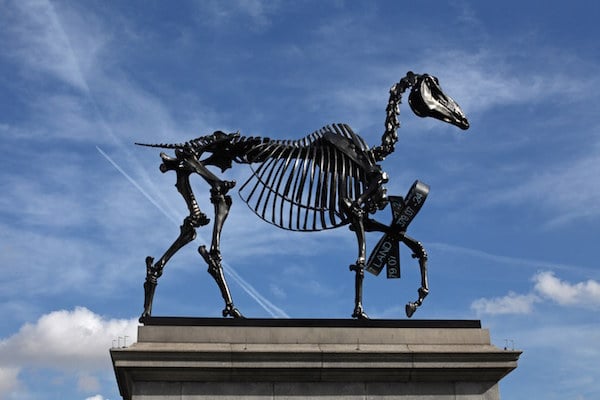
Photo: Fourth Plinth
Yesterday morning, the German artist Hans Haacke unveiled his equestrian sculpture for London’s Fourth Plinth, one of England’s most renowned publicly-funded art commissions (see Katharina Fritsch’s Cock on London’s Fourth Plinth to Be Replaced by Hans Haacke’s Horse).
Rather than a shiny, brawny horse, Haacke has given London its mere skeleton, with its left leg stopped mid-step and decorated with an electric ribbon that displays the ticker of the London Stock Exchange.
“The title of the piece is Gift Horse, and that implies something is off,” Haacke told the press in Trafalgar Square. Is Haacke’s sculpture a Trojan horse, set at the heart of London’s most touristic square to disrupt and subvert viewers’s placid assumptions? “It’s hard to believe that, in fact, it got here,” Haacke—who will also participate in the forthcoming Venice Biennale (see The 2015 Venice Biennale List of Artists Is Out–See Our Exclusive)—has said of landing the public commission.
Looking at Haacke’s venerable career at the forefront of the combative Institutional Critique art movement, is easy to agree that something is indeed off with this sculpture, standing both scrawny and defiant at the doors of the National Gallery. But it may not be for the reasons Haacke intended.
Gift Horse was unveiled by the Mayor of London, a fact that could have sharpened the acerbic edge of the German artist’s latest act of subversion. Boris Johnson and Haacke make an unlikely pair, considering Haacke’s celebrated oeuvre, which has targeted a wide-range of figures in power—from museum personalities to corporations and politicians.
But if Johnson felt targeted, he certainly didn’t show it. “There will be those, of course, who see this underfed beast, this emaciated quadruped, as a warning, a memento mori, a symbol of the obsessive pursuit of austerity and the George Osborne diet approach to life, but I say no, my friends, absolutely not!,” he asserted, brimming with chutzpah, seconds before the sculpture was unveiled. Instead, for Johnson, the sculpture confirms London’s status as “not just the financial, but also the artistic capital of the world.” And just like that, the critical nature of the artwork was swifly co-opted by the conservative Mayor.
Hans Haacke converses with the Mayor of London, Boris Johnson, during the unveiling of Gift Horse
Photo via: Newstimes
For someone with such a cemented reputation in the art world for crafting inflammatory works, Haacke is surprisingly soft-spoken and mild mannered. When asked by the press whether his piece was a critique of austerity measures and the ruthless stock markets, the New-York based artist, who will turn 79 this year, opted for a mild reply:
“The piece is an invitation to make connections, but I wouldn’t like to give directions as to what those connections are,” he said. “I’m sure there will be a diversity of responses, as is typical of public art.”
What seems clear is that Haacke’s work is a commentary on history, and the history of art. His skeletal, riderless horse is a pun on the equestrian sculpture of William IV originally commissioned for the plinth in 1841, but uncompleted due to insufficient funds. It is also a homage to the work of the British artist George Stubbs, whose print The Anatomy of the Horse (1766) inspired Haacke’s piece. Stubbs’s oeuvre, moreover, is part of the collection of the National Gallery, which looms behind Gift Horse.
Institutional art spaces hold a special power for Haacke, who is best known for his highly critical museum-inspired pieces that didn’t leave much room for ambiguous interpretations.
A good example of this is his now iconic installation MoMA Poll (1970), in which he asked viewers to comment on the stance of Nelson Rockefeller, then Governor of New York, on the Vietnam War. As it happens, Rockefeller was MoMA’s former president as well as a leading donor, and he wasn’t happy. Haacke didn’t show at MoMA again until the late 80s, according to the Guardian.
But, what about outdoor, public sculpture? Is it an equally inspiring context?
“Public sculpture is one of the things I do,” Haacke told artnet News. “I have two in Berlin, for example: one in the Reichstag and a memorial for Rosa Luxemburg. It’s a type of work that I feel comfortable doing depending on the situation.”
What was appealing about the Fourth Plinth, then?
“It is a very prominent space, where a lot of people will see the work. And there are also other statues that the work can dialogue with,” Haacke told artnet News. “The plinth has been empty for 150 odd years, and to make it available for contemporary artists is a great idea. I am very impressed by it.”